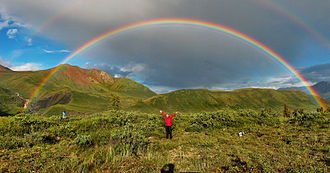


The antisolar point is the abstract point on the celestial sphere directly opposite the Sun from an observer's perspective. [1] This means that the antisolar point lies above the horizon when the Sun is below it, and vice versa. On a sunny day, the antisolar point can be easily found; it is located within the shadow of the observer's head. Like the zenith and nadir, the antisolar point is not fixed in three-dimensional space, but is defined relative to the observer. Each observer has an antisolar point that moves as the observer changes position.
Contents
The antisolar point forms the geometric center of several optical phenomena, including subhorizon haloes, rainbows, [2] glories, [3] the Brocken spectre, and heiligenschein. Occasionally, around sunset or sunrise, anticrepuscular rays appear to converge toward the antisolar point near the horizon. [4] However, this is an optical illusion caused by perspective; in reality, the "rays" (i.e. bands of shadow) run near-parallel to each other. [5]
Also around the antisolar point, the gegenschein is often visible in a moonless night sky away from city lights, arising from the backscatter of sunlight by interplanetary dust. In astronomy, the full Moon or a planet in opposition lies near the antisolar point. During a total lunar eclipse, the full Moon enters the umbra of Earth's shadow, which the planet casts onto its atmosphere, into space, and toward the antisolar point.